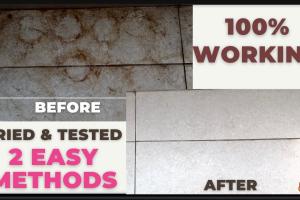Ultimate Guide to Removing Stains from Tiles: Expert Tips & Tricks

-
Quick Links:
- Introduction
- Understanding Different Tile Materials
- Common Types of Stains on Tiles
- Preparation for Stain Removal
- Step-by-Step Stain Removal Techniques
- Case Studies: Successful Stain Removals
- Expert Insights on Tile Care
- FAQs
- Conclusion
Introduction
Tiles are a popular choice for flooring and wall coverings due to their durability and aesthetic appeal. However, they are not immune to stains, which can detract from their beauty. Understanding how to effectively remove stains from tiles is essential for maintaining their appearance and extending their lifespan. In this comprehensive guide, we will explore various methods and techniques for stain removal, including DIY solutions, expert tips, and case studies.
Understanding Different Tile Materials
Before diving into stain removal techniques, it's important to understand the different types of tile materials, as each type requires specific care:
- Ceramic Tiles: Durable and resistant to moisture, but can stain if not sealed properly.
- Porcelain Tiles: Denser and less porous than ceramic, making them more stain-resistant.
- Natural Stone Tiles: Such as granite or marble, are porous and require regular sealing to prevent stains.
- Vinyl Tiles: Affordable and versatile, but can be scratched easily if not cared for.
Common Types of Stains on Tiles
Understanding the type of stain is crucial for selecting the right removal method. Here are some common stains:
- Food and Beverage Stains: Coffee, wine, and grease can leave unsightly marks on tiles.
- Soap Scum: Often found in bathrooms, this can dull the finish of tiles.
- Hard Water Stains: Mineral deposits can accumulate, especially in areas with hard water.
- Grime and Dirt: Regular foot traffic can lead to a buildup of dirt and grime.
Preparation for Stain Removal
Before attempting to remove stains, proper preparation is key:
- Assess the Stain: Identify the type of stain and the tile material.
- Gather Materials: Collect necessary cleaning supplies, such as sponges, brushes, and cleaning solutions.
- Test in a Small Area: Always test your chosen cleaning solution in an inconspicuous area to ensure it doesn’t damage the tile.
Step-by-Step Stain Removal Techniques
Here are detailed methods for removing various types of stains from tiles:
Removing Food and Beverage Stains
For food stains, follow these steps:
- Blot the stain with a clean cloth to remove excess liquid.
- Mix a solution of warm water and mild dish soap.
- Apply the solution to the stain using a soft sponge, scrubbing gently.
- Rinse with clean water and dry with a towel.
Eliminating Soap Scum
To tackle soap scum:
- Spray a mixture of equal parts vinegar and water on the affected area.
- Let it sit for 5-10 minutes.
- Scrub with a soft-bristled brush and rinse thoroughly with water.
Cleaning Hard Water Stains
For hard water stains, try the following:
- Apply a paste of baking soda and water to the stained area.
- Let it sit for 15-20 minutes.
- Scrub gently with a sponge and rinse well.
Removing Grime and Dirt
To remove accumulated dirt:
- Vacuum or sweep the area to remove loose dirt.
- Use a steam cleaner for deep cleaning.
- For stubborn spots, apply a commercial tile cleaner as per the instructions.
Case Studies: Successful Stain Removals
Here are a couple of real-life examples of successful stain removals:
Case Study 1: Kitchen Tile Restoration
A homeowner struggled with grease stains on their ceramic kitchen tiles. After trying various methods unsuccessfully, they decided to use a commercial degreaser. The result was remarkable; the tiles regained their original shine.
Case Study 2: Bathroom Tile Revival
A family faced persistent soap scum buildup in their shower. They implemented a weekly vinegar and baking soda routine, which not only removed the scum but also kept it from returning.
Expert Insights on Tile Care
We consulted a cleaning expert for their top tips on tile maintenance:
- Regular Cleaning: Clean tiles regularly to prevent stains from setting in.
- Seal Natural Stone: Always seal natural stone tiles to protect against stains.
- Avoid Abrasives: Use non-abrasive cleaners to prevent scratching.
FAQs
1. How often should I clean my tiles?
It is recommended to clean tiles at least once a week to prevent dirt buildup.
2. Can I use bleach on all tile types?
Bleach can damage certain tile types, particularly natural stone. Always check the manufacturer's recommendations.
3. What is the best way to remove grout stains?
A mixture of baking soda and vinegar can effectively remove grout stains.
4. Are there any eco-friendly tile cleaning solutions?
Yes, vinegar, baking soda, and lemon juice are effective eco-friendly alternatives.
5. How do I prevent stains from returning?
Regular cleaning and sealing tiles can help prevent future stains.
6. Is it necessary to seal ceramic tiles?
Ceramic tiles are generally less porous, but sealing can enhance their stain resistance.
7. Can I use a steam cleaner on all tiles?
Most tiles can be cleaned with a steam cleaner, but check specific tile materials for compatibility.
8. What should I do if stains persist?
If stains persist, consider consulting a professional cleaning service.
9. How can I remove mold from tiles?
A mixture of water and bleach or a commercial mold remover can effectively eliminate mold.
10. What is the best product for tile stain removal?
Look for a product specifically designed for your tile type and stain type for the best results.
Conclusion
Removing stains from tiles doesn't have to be a daunting task. With the right methods and preventative measures, you can keep your tiles looking pristine. Regular maintenance is key, and understanding the specific needs of your tile material will ensure long-lasting beauty in your home. Whether you go for DIY solutions or professional cleaning, the tips and techniques outlined in this guide will help you tackle any stain with confidence.